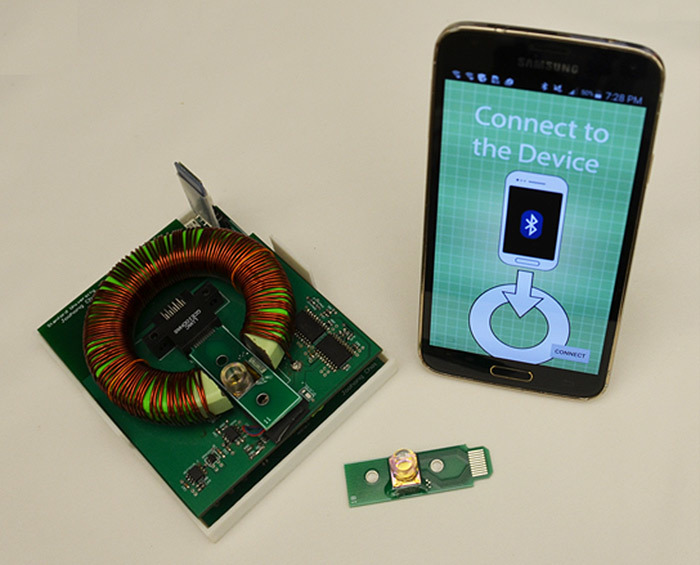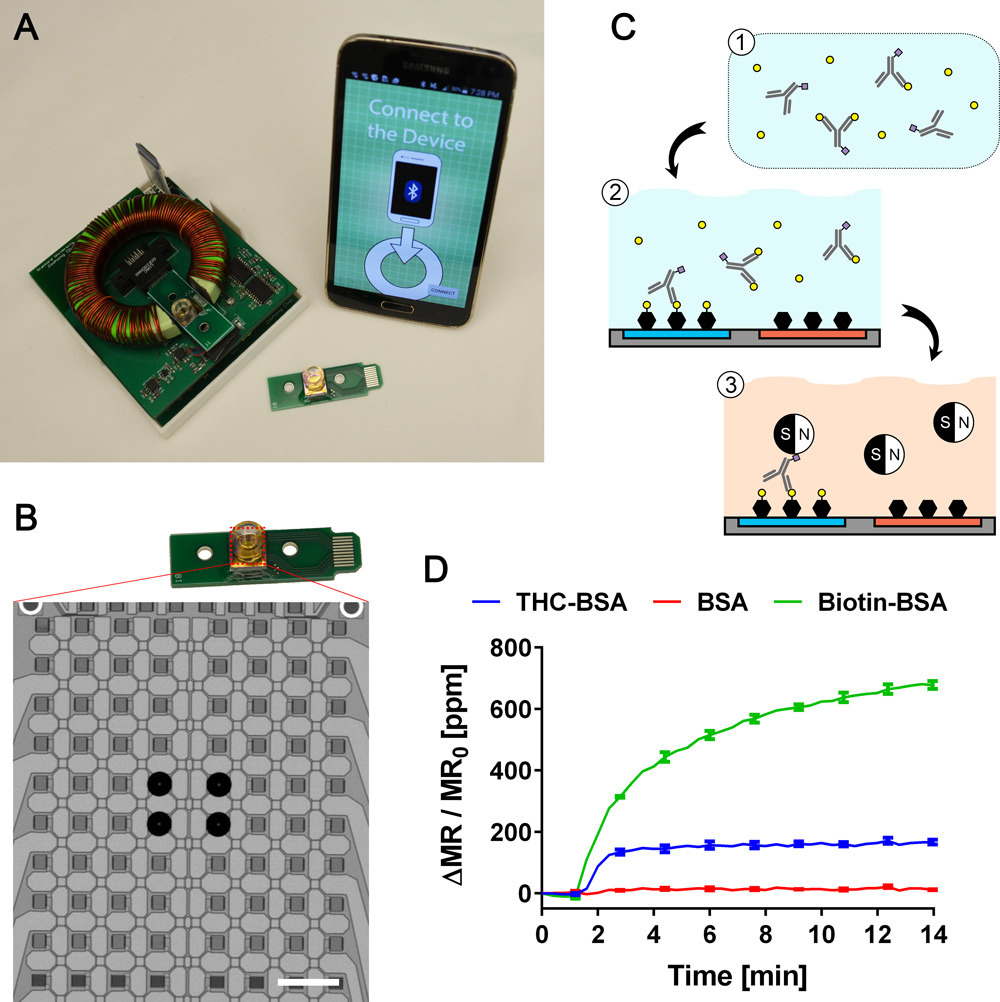Three minutes on the pattern of saliva. First field test for marijuana developed

The prototype field test for marijuana. In the center is a disposable cartridge with magnetoresistive sensors coated with THC (the main psychoactive substance of marijuana), on the left is a 105 × 90 mm handheld scanner, on the right is a smartphone for receiving information via Bluetooth. Photo: Stanford University
In connection with the widespread spread of marijuana in some countries, there was a problem, how to quickly detect the smoked drivers.
According to the SDA, it is prohibited to drive a vehicle “while intoxicated or in a state caused by the use of narcotic drugs, psychotropic, toxic or other intoxicating substances”, in a painful or tired state that endangers road safety, as well as under the influence of drugs, reducing attention and speed of reaction.
Some studies show that using marijuana slightly increases the likelihood of an accident . This substance is included in the list of prohibited for drivers, along with alcohol and other "suicidal" drugs. It can be considered an "intoxicating substance" or a "drug that reduces the rate of reaction." Under the influence of a large amount of marijuana, drivers begin to drive more slowly than usual, lately react to what is happening and create dangerous situations on the road.
')
Currently, marijuana is legalized in one form or another in 20 American states, and in November, after the referendum, they will almost certainly be joined by a few more (in referenda, people usually speak in favor of decriminalizing and legalizing a light drug). This means that the police will have an even more urgent need for field testing of citizens. The test should be more or less accurate and quick to check for suspicious drivers on the road, like a breathalyzer. Until now, there is not a single device on the market that meets these requirements.
An experienced narcologist instantly recognizes the stoned patient, but for his detention on the road, formal grounds are necessary, and not just the inspector’s subjective opinion that the driver has “too red eyes” and “slow speech”. The same breathalyzer is easy to fool - it often gives inaccurate readings. But absolute accuracy is not needed here, only formal grounds for detention are needed. If the driver does not agree, he can always take a blood or urine test and determine the exact content of tetrahydrocannabinol (THC) in the body - the main psychoactive component of marijuana.
Specialists from Stanford University (USA) have developed the world's first field test for marijuana intoxication . Potentially, this test may be suitable for use on the road.
The developed device determines not only the presence of THC in saliva, but also the concentration of the substance. The device was designed by a group of researchers led by Shan Wan , a professor of materials science at Stanford University. For several years his group has been studying the possibilities of magnetic nanotechnology for the development of bioscanners of various purposes. For example, they previously created instruments for diagnosing cancer and even magnetic data storage devices.
A new device uses magnetic biosensors that detect the THC molecule in saliva. In this case, magnetic nanotechnology is combined with tested and well-proven immunoassay techniques. Immunoassay is a biochemical test for measuring the concentration of macromolecules or small molecules with antibodies (usually) or antigens (rarely).
During testing, a sample of saliva is mixed with THC antibodies. They bind to all THC molecules in the sample. Then the sample is placed in a disposable cartridge with magnetoresistive sensors (GMR), also covered with THC. After that, the hand scanner records how many antibodies are contacted with THC on the magnetoresistive sensors. From this information, it is concluded how many antibodies are bound to the THC molecules in the subject's saliva.
The test is pretty accurate. Antibody counting is performed using special magnetic nanoparticles that bind to THC-antibody vapors on magnetoresistive sensors. The result from the hand scanner is transmitted via Bluetooth to a smartphone or laptop.

The GMR biosensor chip in the cartridge contains 80 biosensors plus 8 sensors in the bottom row for an electrical reference. The photo shows that the THC molecules are fixed by four sensors in the middle. Photo: Stanford University
When examined in the field, an inspector can take a sample of saliva with a cotton swab — and get the results on a smartphone or laptop within three minutes. This is an acceptable result for a quick examination.
According to scientists, the content of THC in saliva will allow even more accurately determine the degree of intoxication with marijuana than the content of THC in urine or blood. Obviously, immediately after consuming marijuana, the THC content in the saliva will be higher than in the blood, until the substance is completely absorbed into the body. Moreover, such a test is less invasive than a blood test.

Double cartridge and the results of simultaneous measurement of two samples. Photo: Stanford University
In some states the limit of the minimum allowed concentration of THC in the blood is not set at all. In others, there is a minimum limit of 5 nanograms per milliliter of blood. Scientists have not yet come to a common opinion, which concentration of THC exerts too much influence on the driver’s attention and speed of reaction. Opinions are expressed that the concentration ranges from 2 to 25 ng / ml. The developed device determines the concentration of THC in the range from 0 to 50 nanograms per milliliter of saliva. This is fully compliant with regulatory requirements.
In principle, conducting such field tests in the future may become a routine procedure. Confused only by the unknown cost of disposable cartridges with GMR-sensors. Still, bioelectronics are unlikely to be cheap. However, the cost of the examination can be collected from the driver if his sample confirms an unacceptably high concentration of THC (that is, the cost of the examination should be included in the amount of the fine for violation).
By the way, theoretically 80 sensors on a chip allow you to check a sample of saliva for the content of not only THC, but also other substances. Researchers are now testing antibodies for morphine molecules (the main alkaloid of opium) - and have received encouraging results.
The scientific work describing the bioplatform was published on July 19, 2016 in the journal Analytical Chemistry (doi: 10.1021 / acs.analchem.6b01688).
Source: https://habr.com/ru/post/397617/
All Articles